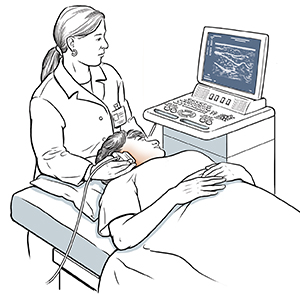Doppler Ultrasound
Doppler Ultrasound

How to I get ready for an ultrasound?
The test takes 30 to 60 minutes. Allow time to check in. When you arrive, you may be asked to undress from the waist down or to change into a gown. The person who performs the ultrasound is called a sonographer.
What to tell the sonographer
Tell your sonographer if:
You’ve had a stroke
You’ve had symptoms, such as short-term loss of strength, problems with speech, vision, or pain or swelling in your arms or legs
What happens during an ultrasound?
The ultrasound may be done on your neck, abdomen, leg or arm, depending on the area of your problem.
If the test is done on your neck
You will lie on an exam table.
Your head will be turned to the side.
Nongreasy gel will be applied to your neck.
The sonographer will then press a hand-held transducer (probe) against your neck.
If the test is done on your abdomen, leg or arm
Nongreasy gel will be applied to the skin over the area to be examined.
The probe will be pressed against the skin over the gel.
Although the sonographer can answer questions about the test, only a doctor can explain the results.
Your test results
Before leaving, you may need to wait briefly while your images are being reviewed. Your doctor will discuss the test results with you during a follow-up appointment or over the phone.
Your next appointment is:____________________
Updated:
September 08, 2018
Reviewed By:
Image reviewed by StayWell medical illustration team.,Sudheendra, Deepak, MD,Turley, Ray, BSN, MSN